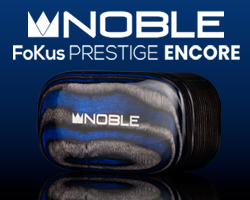British hi-fi manufacturer, Mitchell and Johnson, announced an exclusive worldwide deal with the developers of Electrostatz technology for use in its forthcoming range of headphones.
The self-biasing electrostatic technology behind Electrostatz was originally developed at the Industrial Technology Research Institute (ITRI), Taiwan’s largest industrial research facility. Further commercial development was rewarded with the highly prized accolade of “Technology Innovation Award Winner” from The Wall Street Journal and it was subsequently patented as Electrostatz Technology.
The super-thin and lightweight flexible transducer, with many thousands of micro-perforations, produces sound waves when an audio signal is applied to the driver in much the same way as a traditional electro-static driver, but without the need for an external high voltage power supply. This overcomes the two major disadvantages that exist with current electro-static headphones, namely high cost and lack of portability.
Electrostatz is capable of reproducing high frequency sounds up to 45kHz, with an incredibly quick response. In order to produce the punchy low frequency sounds required for the full frequency experience, which would require a high voltage input if using an electro-static driver on its own, the Mitchell and Johnson approach is to utilise a hybrid design. A dynamic driver dedicated to the bass works in conjunction with the Electrostatz unit for the mid and high frequencies.
Mitchell and Johnson has signed an agreement with the company behind Electrostatz to bring the technology to consumers across a range of new headphone models. During the first half of 2016 the company will introduce designs aimed at the street or urban users, hifi enthusiasts, DJs and professional studio engineers.
Paul Mitchell, CEO, of Mitchell and Johnson comments, “Electrostatz represents the single biggest development in headphone driver design for many years. And by combining it with a dynamic driver in our hybrid module we can bring the best of both worlds – electrostatic purity and dynamic power and bass performance – to consumers. As we are using two drivers in the headphones, we can tune the frequency response in much the same way as a traditional loudspeaker balance can be altered. This gives us the ability to create models that are suited to different applications, for example biased to cut through the ambient noise of an urban setting, or a perfectly flat response for studio use.” He concludes, “We are very excited to be granted the worldwide exclusivity on the technology and can’t wait to share our first designs with music fans over the coming months.”























































































































































































































You must be logged in to leave a reply.